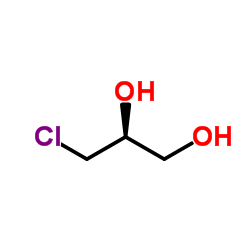(2S)-3-Chlorpropan-1,2-diol

(2S)-3-Chlorpropan-1,2-diol structure
|
Common Name | (2S)-3-Chlorpropan-1,2-diol | ||
|---|---|---|---|---|
| CAS Number | 60827-45-4 | Molecular Weight | 110.539 | |
| Density | 1.3±0.1 g/cm3 | Boiling Point | 213.0±0.0 °C at 760 mmHg | |
| Molecular Formula | C3H7ClO2 | Melting Point | N/A | |
| MSDS | Chinese | Flash Point | 113.3±21.8 °C | |
| Symbol |


GHS05, GHS06 |
Signal Word | Danger | |
|
Complete detoxification of tris(1,3-dichloro-2-propyl) phosphate by mixed two bacteria, Sphingobium sp. strain TCM1 and Arthrobacter sp. strain PY1.
J. Biosci. Bioeng. 113(1) , 79-83, (2012) Tris(1,3-dichloro-2-propyl) phosphate (TDCPP), a flame retardant, is regarded as a potentially toxic and persistent environmental contaminant. We previously isolated a TDCPP-degrading bacterium, Sphingobium sp. strain TCM1, which, however, produced a toxic me... |
|
|
Passage of MHPG from plasma to CSF in a non-human primate.
Rev. Med. Chir. Soc. Med. Nat. Iasi. 115(4) , 1278-82, (2011) In experimental protocols with humans and non-human primates, cerebrospinal fluid (CSF) concentrations of 3-methoxy-4-hydroxyphenylethylene glycol (MHPG), the predominant end-product of norepinephrine metabolism in the mammalian central nervous system (CNS), ... |
|
|
Fatty acid esters of monochloropropanediol (MCPD) and glycidol in refined edible oils.
Food Addit. Contam. Part A. Chem. Anal. Control. Expo. Risk Assess. 30(1) , 46-51, (2013) Recently, fatty acid esters of monochloropropanediol (MCPD) and that of glycidol have been reported in refined edible oils. Since then a wealth of research has been published on the factors influencing the formation of these contaminants in foods. It can be n... |
|
|
Toxicological assessment of 3-chloropropane-1,2-diol and glycidol fatty acid esters in food.
Mol. Nutr. Food. Res. 55(4) , 509-21, (2011) Fatty acid esters of 3-chloropropane-1,2-diol (3-MCPD) and glycidol are a newly identified class of food process contaminants. They are widespread in refined vegetable oils and fats and have been detected in vegetable fat-containing products, including infant... |
|
|
An evaluation of the chick cardiomyocyte micromass system for identification of teratogens in a blind trial
Reprod. Toxicol. 28(4) , 503-10, (2009) The chick micromass culture system has advantages over the validated rat system – ready availability and non-culling of the donor parent – but needs to give comparable results. This study confirmed comparability and the ability to extend the system to cover c... |
|
|
1,3-Dichloro-2-propanol inhibits progesterone production through the expression of steroidogenic enzymes and cAMP concentration in Leydig cells.
Food Chem. 154 , 330-6, (2014) 1,3-Dichloro-2-propanol (1,3-DCP) is a well-known food processing contaminant that has been shown to impede male reproductive function. However, its mechanism of action remains elusive. In this study, the effects of 1,3-DCP on progesterone production were inv... |
|
|
Developmental toxic potential of 1,3-dichloro-2-propanol in Sprague–Dawley rats
Regul Toxicol Pharmacol 53(1) , 63-9, (2009) This study investigated the potential adverse effects of 1,3-dichloro-2-propanol (1,3-DCP) on pregnant dams and the embryo-fetal development after maternal exposure on gestational days (GD) 6 through 19 in Sprague–Dawley rats. The test chemical was administer... |
|
|
Combined solid-phase extraction and gas chromatography-mass spectrometry used for determination of chloropropanols in water.
J. Sep. Sci. 34(19) , 2697-704, (2011) A sensitive and rapid derivatization method for the simultaneous determination of 1,3-dichloro-2-propanol (1,3-DCP) and 3-chloropropane-1,2-diol (3-MCPD) in water samples has been developed. The aim was to research the optimal conditions of the derivatization... |
|
|
Solid-phase micro-extraction procedure for the determination of 1,3-dichloro-2-propanol in water by on-fibre derivatisation with bis(trimethylsilyl)trifluoroacetamide.
Anal. Bioanal. Chem 394(3) , 893-901, (2009) The headspace solid-phase micro-extraction technique with on-fibre derivatisation followed by gas chromatography-tandem mass spectrometry has been evaluated for the analysis of 1,3-dichloro-2-propanol in water. An asymmetric factorial design has been performe... |
|
|
Application of the margin of exposure (MoE) approach to substances in food that are genotoxic and carcinogenic: example: (CAS No. 96-23-1) 1,3-dichloro-2-propanol (DCP).
Food Chem. Toxicol. 48 Suppl 1 , S57-62, (2010) 1,3-Dichloro-2-propanol (DCP) is formed in foods under a variety of conditions. It was positive in a variety of in vitro genotoxicity tests, but was negative in two in vivo studies. DCP produced neoplasms at several sites in rats. Kidney tumours in male rats ... |